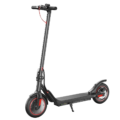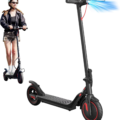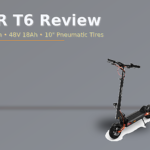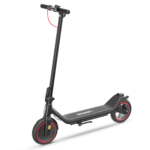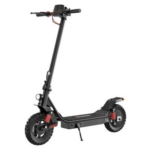- Home
- Scooters
- Electric Scooters
- iScooter iX4
iScooter iX4
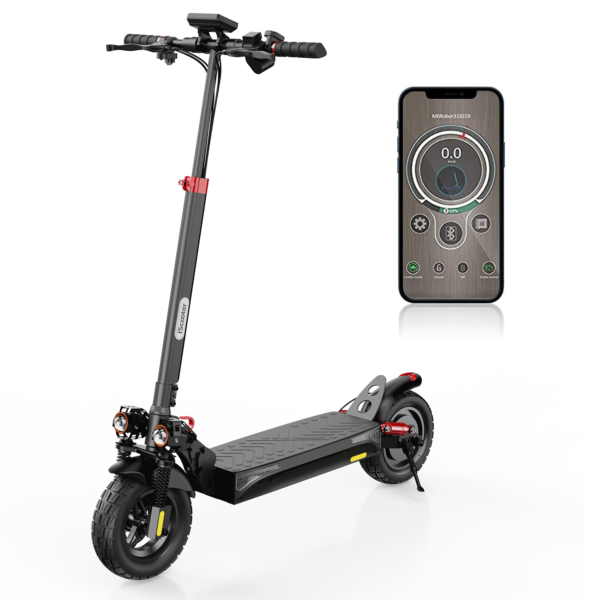



- Battery Range: 28 miles (45 km)
- Top Speed: 28 mph (45 km/h)
- Motor Power: 800 W rear hub (RWD)
- Weight Capacity: 330 lb (150 kg)
- Charging Time: ~6–8 h
- Scooter Weight: 55.1 lb (25.0 kg)
PROS
- 28 mph top speed
- 48V 15Ah (720 Wh) battery
- Disc + E-ABS braking
- 10″ pneumatic off-road tires
- IPX4 water resistance
- Minirobot app support
CONS
- Heavy at 55.1 lb
- Single motor acceleration
- No hydraulic brakes
- Official range modest (28 mi)

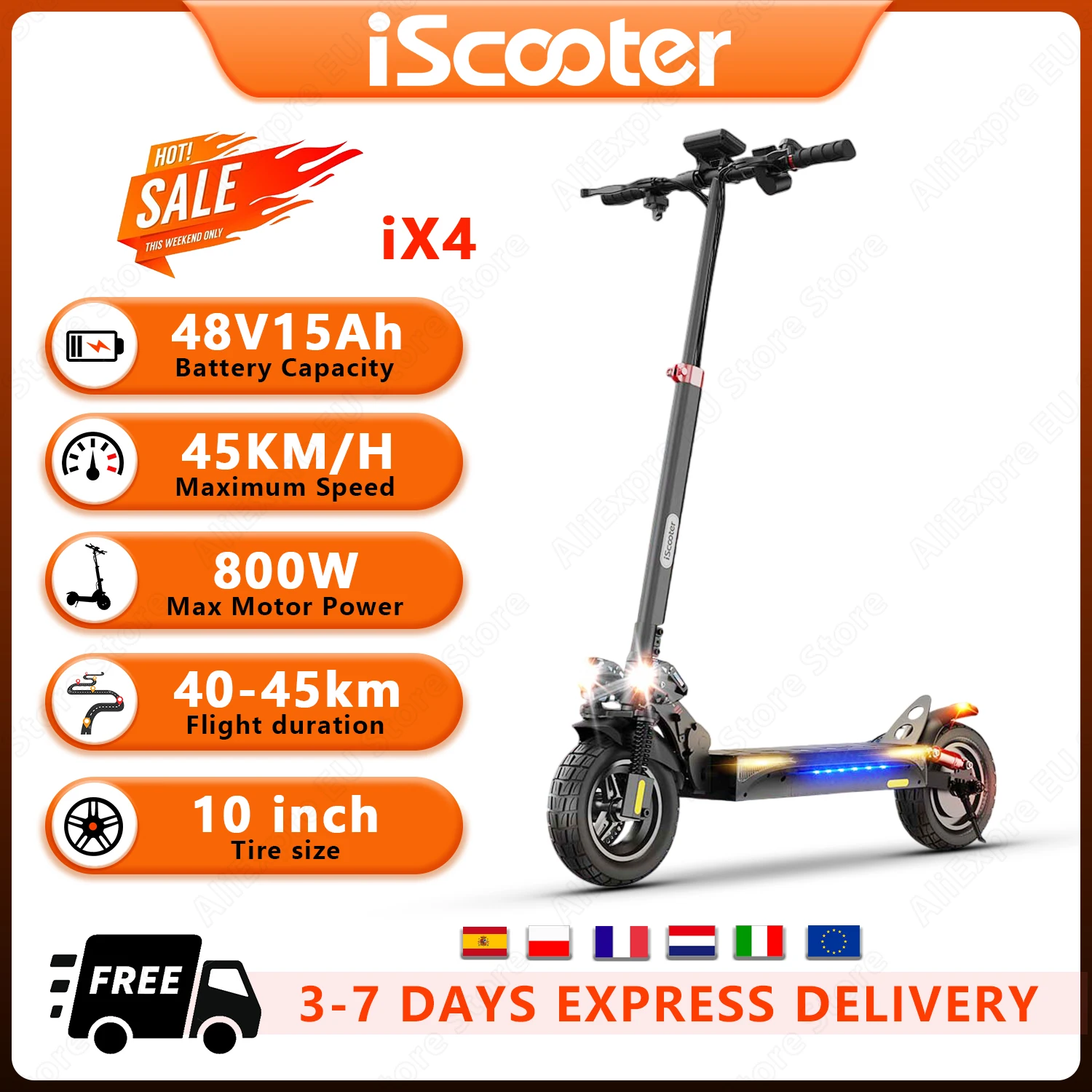



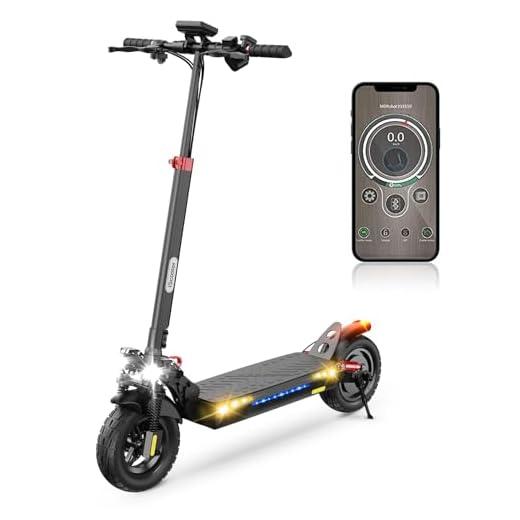
Table of contents
- What Is the iScooter iX4?
- How the iScooter iX4 Works
- Key Specifications
- Design & Build Quality
- Performance Fundamentals
- Battery, Range & Efficiency
- Ride Quality & Comfort
- Braking & Safety Features
- Portability & Daily Usability
- Maintenance & Care
- Weather & Seasonal Considerations
- iScooter iX4 vs Alternatives
- Who the iScooter iX4 Is (and Isn’t) For
- FAQs
- Glossary
- Final Thoughts
The iScooter iX4 is a robust, all-terrain-ready electric scooter built for riders who want more grip, more comfort, and more headroom for speed than a basic city commuter. It pairs a torquey rear-wheel motor with dual suspension and 10-inch off-road pneumatic tires, so it feels stable on patchy bike lanes and predictable on hard-packed paths. If you want a practical daily scooter that can also handle weekend detours, the iScooter iX4 deserves a careful look. If you’re also considering a slimmer commuter, compare it with the iScooter i10 Pro.
What Is the iScooter iX4?
The iScooter iX4 sits in the brand’s off-road line, above the entry-level commuters and below the dual-motor heavyweights. It’s a single-motor, rear-drive scooter rated at 800 W with a 48 V, 15 Ah battery and a manufacturer-stated top speed of 28 mph (45 km/h). In practice, the iScooter iX4 aims for confident cruising, forgiving suspension, and clear rider feedback from a full-color display and onboard controls. You also get turn signals, a bell, a bright headlight, and an app connection for settings and ride data.
But the real appeal is the balance: the iScooter iX4 offers enough punch for hills around town, enough chassis to stay composed at speed, and enough comfort that everyday potholes don’t dominate the ride. It’s not a track toy and it’s not a featherweight last-mile folder; instead, it’s a do-most-things scooter that remains manageable to store and carry when you need to.
How the iScooter iX4 Works
At a glance, an electric scooter looks simple. Yet the system inside the iScooter iX4 is a tight loop of parts that constantly talk to each other:
- Motor & Controller: The rear hub motor translates electrical power into forward thrust. A controller—think of it as the scooter’s brain—meters that power thousands of times per second. When you ask for more speed, the controller increases current to the motor smoothly, so acceleration feels progressive rather than jerky.
- Battery & BMS: The 48 V, 15 Ah pack stores energy. A battery management system (BMS) protects the cells during charge and discharge, balancing them for longevity. Because the iScooter iX4 uses a 48 V architecture, it can deliver solid torque while keeping current at manageable levels, which helps efficiency and temperature control.
- Throttle & Modes: Your right-hand control sends a signal to the controller—more input, more power. The iScooter iX4 offers multiple ride modes (comfort/eco to turbo) that limit top speed and throttle aggressiveness. Riders can tailor response for busy paths, mixed traffic, or open stretches.
- Brakes & Regen: Mechanical disc brakes front and rear provide the main stopping force. Electronic anti-lock braking (E-ABS) supplements them with regenerative braking logic. When you brake, the controller may feed a bit of energy back into the battery while stabilizing wheel speed for grip.
- Lights & Signals: The high-mounted headlight, taillight, brake light, and turn signals make your intent obvious. The iScooter iX4 also includes ambient deck lighting for visibility to others at dusk.
This integration matters. Because the motor is in the rear, traction during hard launches improves, and because the brakes include E-ABS logic, stopping feels steady even on less-than-ideal surfaces.
Key Specifications
Below is a clean, rider-centric summary of the iScooter iX4’s official specifications, with both imperial and metric figures for clarity.
| Block | Details |
|---|---|
| General | Model: iScooter iX4 · Drive: Rear-wheel hub motor · Minimum rider age: 14+ · Max rider weight: 330 lb (150 kg) |
| Performance & Power | Rated/peak motor power: 800 W · Top speed: up to 28 mph (45 km/h) · Typical climb rating: up to ~25% hill grade (short pitches) · Ride modes: Comfort/Eco and Off-Road/Turbo tiers |
| Battery, Charging & Electrical | Battery: 48 V, 15 Ah (≈720 Wh) · Charger output: 54.6 V, 2 A · Charge time: ~6–8 hours · App connectivity: Bluetooth via MiniRobot app |
| Build & Dimensions | Tires: 10 in (25.4 cm) off-road pneumatic · Suspension: Dual (front + rear) · Unfolded size: ~47 × 25.5 × 50 in (120 × 65 × 128 cm) · Folded size: ~47 × 8.6 × 19.6 in (120 × 22 × 50 cm) · Net weight: ~55.1 lb (25 kg) |
| Safety & Control | Brakes: Front mechanical disc + rear mechanical disc with E-ABS electronic assist · Lights: Front headlight, rear light, brake light (flashing), left/right turn signals, ambient deck lighting · Bell: Yes |
| Features & Extras | Full-color display (speed, battery, temp, odometer, trip, modes, turn signals, headlight, alerts) · Cruise Control: Yes · Three-step folding mechanism · Keyed ignition (select versions/regions) |
| Warranty & Compliance | Limited warranty: 12 months (varies by region; excludes consumables) · Water resistance: IPX4 · Regulatory: CE/FCC declarations provided by manufacturer |
Design & Build Quality
Design choices on the iScooter iX4 emphasize stability and clear feedback. The frame uses aluminum alloy tubing with generous welds at high-stress junctions. This helps stiffness without adding unnecessary weight. Because the motor lives in the rear hub, the front wheel remains light and communicative over lane patches and expansion joints.
The deck is long enough to adjust your stance during longer rides. You can ride neutral-footed for control or offset your feet when you want more leverage under braking or on climbs. Grip tape coverage spans nearly the full deck, so your shoes find traction even in light mist.
Up front, the stem locks into place with a multi-step mechanism: a primary latch, a safety catch, and a sliding collar. The setup purposely slows down folding by a few seconds, yet it pays off with fewer creaks at speed. Stem flex is present—virtually all folding scooters have some—but the iScooter iX4 keeps it modest and predictable.
The cockpit uses a full-color display that remains readable in bright daylight. Your speed, battery state, ride mode, turn-signal status, and light status are always visible. The control cluster keeps the horn, light, and mode buttons reachable without shifting your grip. Meanwhile, the grips themselves lock on securely, resisting rotation during hard braking.
Finally, the fit-and-finish avoids unnecessary gloss; edges are chamfered, wiring runs are guided and sleeved, and the fender alignment looks tidy. This is the sort of scooter that feels put together to be used, not just photographed.
Performance Fundamentals
The first thing you notice about the iScooter iX4 is its acceleration feel. Because the motor drives the rear wheel, launches are composed. In Comfort/Eco mode, throttle ramp is gentler, which is helpful in crowded areas or when you’re learning the scooter’s response. In Off-Road/Turbo, there’s a firmer push off the line; however, it remains manageable. As a result, stop-and-go traffic doesn’t feel like a chore.
Cruising stability is another strength. The 10-inch off-road pneumatics, combined with dual suspension, filter out the chatter that would otherwise travel through the stem. At neighborhood speeds, steering is light with a touch of self-centering. At higher speeds, the stance widens naturally as you lower your chest, which damps small head movements. Because the iScooter iX4 emphasizes rear traction, powering over small surface changes rarely unsettles the scooter.
On hill climbs around 7–10% grades, the iScooter iX4 holds speed better than typical 36 V commuters. You’ll still slow slightly on long grades—single-motor scooters do—but the bike-lane pace remains practical. Short steeper ramps are passable, especially if you carry momentum and use Turbo mode before the slope begins.
Battery, Range & Efficiency
Battery behavior depends on more than capacity. The iScooter iX4 pairs a 48 V, 15 Ah pack (about 720 Wh) with a controller tuned for steady current draw. Consequently, it feels linear on throttle without harsh spikes that waste energy as heat.
- Rated vs real-world range: The rated range is up to 28 miles (about 45 km) under favorable conditions. In everyday mixed riding—starts, stops, some headwind—you should plan for less. Lighter riders on flatter routes in Comfort/Eco mode will naturally see more. Heavier riders, hills, and cold temperatures bring range down.
- Rider weight: Closer to the 330 lb (150 kg) limit, expect range to drop, especially if you accelerate hard in Turbo. Smooth roll-on and relaxed cruising can claw back several miles.
- Terrain & surface: Rough chipseal, wet patches, and climbs increase rolling and aerodynamic losses. Conversely, smooth asphalt and steady speeds improve efficiency.
- Temperature: Lithium-ion cells prefer mild conditions. Cold mornings can temporarily reduce available capacity. Warm up the pack gently with an easy first mile before asking for maximum power.
- Charging best practices: Use the included 54.6 V, 2 A charger on a cool, ventilated surface. Avoid running the battery to zero; charging between roughly 20% and 85–90% for daily use supports longevity. For storage longer than a few weeks, leave the pack around half charge, and top it up every month or so.
Because the iScooter iX4 includes regenerative logic, very gentle braking can return a small amount of energy. It’s not a substitute for the wall charger; however, it helps smooth stops and reduces pad wear.
Ride Quality & Comfort
Comfort starts with pneumatic tires. The iScooter iX4’s 10-inch off-road tires use internal air to cushion small impacts and conform to imperfect surfaces. On hard-packed paths, they track well without feeling squirmy. In the city, they smooth edges and reduce hand fatigue.
The dual suspension adds a second layer of control. It filters mid-size hits—expansion joints, paver transitions, tree-root ridges—without the bounce of overly soft setups. Therefore, you spend less time bracing and more time steering. When you stand tall and relax your elbows, the chassis glides rather than chatters.
Ergonomics suit a wide range of riders. The bars are tall enough for average to above-average heights, and the deck allows a staggered stance that loads the rear wheel under power. Stem flex remains within a comfortable band: you feel the road, but the front never wanders.
For longer rides, cruise control helps. Once engaged at a steady pace, it lets you relax your throttle hand on longer, open sections. Pressing the brake cancels it immediately, giving you control the moment you need it.
Braking & Safety Features
Brakes are your most important performance component. The iScooter iX4 uses mechanical disc brakes at both wheels, which deliver consistent bite and predictable modulation. You feel a firm engagement around the midpoint of the lever stroke; after that, stopping power ramps smoothly. Because the rear tire carries more weight under deceleration, rear grip stays reliable with proper stance.
Electronic E-ABS adds stability by managing wheel speed electronically. You’ll notice it most when braking over rough patches; instead of a skip, the wheel tracks straighter. It also integrates with light regenerative logic to help settle the scooter under braking.
For visibility, the iScooter iX4 includes a high-mounted headlight, a rear light that brightens under braking, turn signals, and ambient deck lighting. These cues help others predict your path. Additionally, a bell provides an audible nudge on shared paths.
Water resistance is IPX4, which means splash protection from all directions. You can ride through light mist or damp surfaces carefully, yet you should avoid heavy rain and standing water.
Portability & Daily Usability
Although the iScooter iX4 isn’t a featherweight, it remains manageable day to day. At about 55 lb (25 kg), most riders can lift it briefly to clear stairs or load a car trunk. The folding sequence takes a few deliberate steps—lower the bars, tuck the grips (if using the folding-grip version), latch the stem—yet the payback is a feel of solidity at speed.
The folded footprint—roughly 47 × 8.6 × 19.6 in (120 × 22 × 50 cm)—slides along a garage wall, under a desk with clearance, or into a hatchback without drama. For security, lock the frame to a fixed anchor when you can, and never leave the scooter powered on unattended. The iScooter iX4’s keyed ignition (on select versions) adds a light deterrent; however, a quality lock remains essential.
Daily routines become simpler when you standardize your checklist: quick tire pressure check, brake lever squeeze test, and a glance at the battery level before you roll. These habits take seconds and prevent surprises.
Maintenance & Care
You don’t need a full toolbox to keep the iScooter iX4 in shape. A light, consistent routine goes far.
- Tire pressure: Check weekly. Stay within the manufacturer’s range for your weight to balance comfort and puncture resistance. Under-inflation increases flats and rolling drag; over-inflation reduces grip.
- Brake adjustment: Mechanical discs gradually wear pads. Center the calipers so the rotor spins freely without rub. If lever travel grows, adjust the cable barrel or the inner pad. Replace pads when friction material thins.
- Fastener checks: Vibration loosens bolts over time. Every 2–4 weeks, inspect stem clamp bolts, axle nuts, caliper mounts, and fender hardware. Use thread-locking compound where recommended.
- Firmware & app habits: Periodically open the app to check for updates, review ride stats, and confirm settings like zero-start and cruise control. Updates can improve reliability and diagnostics.
- Charging & storage: Let the scooter cool a bit after a hard ride before charging. For storage beyond two weeks, park it at about half charge in a cool, dry place, and top up monthly.
Simple schedule (starter guide):
- Every ride: quick visual once-over, tire feel, brake lever test.
- Weekly: tire pressure, bolt glance, light function check.
- Monthly: pad wear check, caliper re-centering, stem clamp torque check.
- Quarterly: full inspection, deep clean, replace worn pads if needed.
Weather & Seasonal Considerations
Weather always shapes range and traction. A little planning goes a long way.
- Rain: With IPX4 splash resistance, you can manage light, brief moisture. Reduce speed and brake earlier; wet rotors and tires need extra distance. Avoid puddles, metal grates, and painted lines.
- Heat: Batteries dislike heat. Park in shade, and avoid leaving the scooter in a closed car. After hot rides, let the pack cool before charging.
- Cold: Range dips in the cold. Start gently for a mile to warm the battery and tires. If your hands get chilled easily, thin gloves maintain feel at the levers.
- Seasonal storage: Before a long break, charge to around 50–60%, clean the scooter, and store it indoors. Resume with a low-power ride to reacquaint yourself with tire feel and brake response.
iScooter iX4 vs Alternatives
Within the scooter landscape, you’ll find commuters, performance machines, and off-road-leaning single-motors like the iScooter iX4.
- Versus city commuters: The iScooter iX4 carries more speed headroom, stronger brakes, and better bump absorption. It weighs more and folds more deliberately, so pure last-mile riders may prefer something lighter.
- Versus dual-motor performance scooters: The iScooter iX4 is simpler, lighter, and easier to maintain. It won’t match the all-out acceleration of two motors; however, it’s friendlier to live with daily and easier to carry.
- Versus budget off-road models: The iScooter iX4 adds useful safety lighting, app features, and a clearer, more informative display. Meanwhile, its chassis feels more settled at speed than ultra-budget frames.
If you commute mixed distances, want real suspension, and appreciate a composed ride on rough city routes, the iScooter iX4 often hits the sweet spot.
Who the iScooter iX4 Is (and Isn’t) For
Ideal for:
- Riders who split time between city streets and hard-packed paths.
- Commuters who want more comfort than a basic 8.5-inch tire scooter can provide.
- Students who value speed headroom and serious lights for early classes or late labs.
- Multi-modal travelers who can lift ~55 lb (25 kg) and want a stable feel at speed.
Not the best fit for:
- Ultra-lightweight last-mile needs where stairs and daily carrying dominate.
- Riders who need extreme torque for very steep, long climbs.
- Anyone who must ride in heavy rain regularly—no small scooter thrives there.
FAQs
1) Is the iScooter iX4 good for daily commuting?
Yes. Because it pairs real suspension with 10-inch pneumatic tires, the iScooter iX4 handles rougher bike lanes without beating you up. Its lighting and turn signals add daily safety, and the folding size fits most trunks.
2) What is the realistic range for the iScooter iX4?
Plan for less than the rated maximum in mixed conditions. Terrain, temperature, rider weight, and speed all matter. Smooth inputs, moderate speeds, and proper tire pressure consistently extend range.
3) Can the iScooter iX4 climb hills comfortably?
On 7–10% grades, the iScooter iX4 keeps a usable pace, especially in Turbo mode. It will slow on long, steep climbs—as all single-motor scooters do—but short ramps are handled well with momentum.
4) Does the iScooter iX4 have cruise control?
Yes. After you enable it in settings, hold a steady speed and the system will maintain it until you brake or change throttle input.
5) How weather-resistant is the iScooter iX4?
It carries an IPX4 splash rating. Light, brief wet conditions are manageable with care, but you should avoid heavy rain and standing water to protect components and maintain traction.
6) What maintenance does the iScooter iX4 require most often?
Tire pressure checks and occasional brake adjustments. Add periodic fastener inspections and keep the charging port cap seated. Small, routine habits prevent most issues.
7) Where can I find an “iScooter iX4 overview” in one place?
Right here. This guide gathers the core facts and practical riding insights so you can evaluate fit, comfort, and daily usability without guesswork.
Glossary
- Ah (Amp-hours): Battery capacity measure; higher Ah means more stored energy at a given voltage.
- Wh (Watt-hours): Battery energy (V × Ah). Directly compares pack sizes across scooters.
- Controller: The electronic module that meters power between the battery and motor.
- Regen (Regenerative Braking): Converts a portion of braking into battery charge while slowing the wheel.
- E-ABS: Electronic anti-lock braking logic that helps keep the wheel from skidding.
- Zero-Start: Allows acceleration from a standstill without a kick; often user-selectable.
- Cruise Control: Maintains a set speed until the rider brakes or changes throttle input.
- Stem Flex: The small, perceptible movement in the folding assembly under load.
- IP Rating: Ingress Protection; IPX4 indicates splash resistance from all directions.
- Peak Power: Highest short-burst motor output; useful for launches and short hills.
- Throttle Curve: How fast the scooter adds power as you roll on the control.
- BMS (Battery Management System): Protects and balances cells for safety and longevity.
- Riding Modes: Preset limits for speed and responsiveness, e.g., Eco/Comfort vs Turbo.
- Disc Brake: A caliper squeezes pads onto a rotor for reliable mechanical stopping.
- Deck: The standing platform; length and grip affect comfort and control.
Final Thoughts
The iScooter iX4 brings together stability, sensible power, and features riders actually use—dual suspension, real tires, strong braking, useful lighting, and clear controls. Moreover, it stays approachable for new riders while offering enough performance headroom to keep experienced riders interested. If you want a scooter that feels sorted on imperfect roads and flexible enough for detours, the iScooter iX4 is an easy recommendation.
Specifications
General
| Model The Model specifies the exact version or name of the scooter. It helps identify its unique design, features, and specifications within the manufacturer’s product line. Knowing the model makes it easier to compare options, find compatible accessories, or look up support information. | iX4 |
| Brand The Brand identifies the manufacturer or company that designs and produces the scooter. A trusted brand is a sign of quality, reliability, and good customer support. Well-known brands often have higher standards for safety, performance, and after-sales service, giving you more confidence in your purchase. | iScooter |
| Release Date The Release Date indicates when the scooter model was officially launched on the market. This helps you know how current the design, technology, and features are. A newer release date often means updated components, improved performance, and the latest safety or smart features. | 17 November 2025 |
| Recommended Age Recommended Age indicates the minimum age range that the scooter is designed for, based on safety, size, and ease of use. Following the recommended age helps ensure that riders can handle the scooter’s speed, weight, and controls comfortably and safely. Always check local laws and use protective gear, especially for younger riders. | 14+ |
Performance & Power
| Motor Power (Wattage) What it means: The motor power, measured in watts (W), shows how strong the scooter’s electric motor is. Why it matters: Higher wattage usually means better acceleration, more torque, and improved performance on hills or rough terrain. For example, a 250W motor is good for flat city roads and light riders, while a 500W or 1000W motor provides more power for faster speeds or climbing steep inclines. | 800 W rear hub (max) |
| Top Speed The Top Speed indicates the maximum speed that the scooter can reach under optimal conditions. It’s usually measured on level ground with a fully charged battery and an average rider weight. A higher top speed allows you to travel longer distances faster, but always ensure you ride within legal speed limits and your personal comfort zone for safety. | 28 mph (45 km/h) |
| Battery Capacity Battery Capacity refers to the total amount of energy the scooter’s battery can store, usually measured in ampere-hours (Ah) or watt-hours (Wh). A higher battery capacity means you can ride longer distances on a single charge, reducing the need for frequent recharging. Keep in mind that actual range can vary depending on rider weight, terrain, speed, and weather conditions. | 48 V 15 Ah (720 Wh) |
| Estimated Range per Charge The Estimated Range per Charge indicates the average distance the scooter can travel on a single full battery charge. This range is calculated under optimal conditions, such as flat terrain, moderate speed, and average rider weight. Real-world range may vary depending on riding style, terrain, weather, and load. A longer range means fewer recharges and greater freedom for longer trips. | up to 28 miles (45 km) |
| Hill Climb Ability Hill Climb Ability describes the maximum incline or slope that the scooter can handle while maintaining stable performance. It’s typically expressed as a percentage or in degrees. A higher hill climb rating means the scooter can tackle steeper hills without losing too much speed or power. Actual climbing performance may vary based on rider weight, battery charge, and terrain conditions. | up to 25% grade |
| Drive System The Drive System refers to how power from the motor is delivered to the wheels. Electric scooters typically use either a hub motor (directly integrated into the wheel) or a chain/belt drive system. A high-quality drive system ensures smooth acceleration, efficient power transfer, and low maintenance. The choice of drive system affects performance, noise level, and overall ride experience. | Rear hub (RWD) |
Charging & Electrical
| Charging Time Charging Time indicates how long it takes to fully recharge the scooter’s battery from empty to 100% using the standard charger provided. Faster charging means less downtime and more time on the road. Actual charging time may vary slightly depending on battery capacity, charger output, and environmental conditions. | Approx. 6–8 hours |
| Battery Type Battery Type refers to the specific technology used in the scooter’s battery, which affects performance, lifespan, weight, and charging time. Most modern electric scooters use high-quality lithium-ion (Li-ion) batteries because they offer a good balance of energy density, durability, and low maintenance. A reliable battery type ensures consistent power delivery and longer riding ranges. | Lithium-ion pack with Smart BMS |
| Removable Battery A Removable Battery means the battery pack can be easily detached from the scooter for convenient charging and replacement. This feature allows you to charge the battery separately, swap it with a spare for extended range, or securely store it indoors in extreme weather. Removable batteries add flexibility and make it easier to keep your scooter powered up wherever you are. | Non-removable internal battery (fixed pack) |
| Regenerative Braking Regenerative Braking is an energy-saving feature that converts some of the energy normally lost during braking back into battery power. When you slow down or brake, the motor works in reverse to generate electricity, which helps extend the scooter’s range and improves overall efficiency. This system also reduces wear on traditional brake components, leading to lower maintenance over time. | Yes (E-ABS electronic brake) |
| Lighting Lighting refers to the built-in front and rear lights that enhance visibility and safety when riding in low-light conditions or at night. Good lighting helps you see the road ahead and ensures that other road users can see you. Many scooters include LED headlights, taillights, and sometimes brake lights or side reflectors for added safety and compliance with local traffic regulations. | LED headlight + rear LED/brake + turn signals + ambient lights |
Build & Dimensions
| Scooter Weight Scooter Weight refers to the total weight of the scooter when fully assembled, including the battery. This affects how easy it is to carry, lift, and store the scooter when not in use. A lighter scooter is more portable and convenient for commuting, especially if you need to carry it upstairs or onto public transport. Keep in mind that a sturdy frame and quality components may add to the weight but also contribute to better durability and ride stability. | 55.1 lb (25.0 kg) |
| Maximum Rider Weight Maximum Rider Weight indicates the highest rider weight that the scooter is designed to safely support while maintaining optimal performance and stability. Staying within this limit helps ensure reliable acceleration, braking, and climbing ability, and it protects the frame, suspension, and motor from excessive strain. Exceeding the recommended limit may reduce performance and increase wear on components. | 330 lb (150 kg) |
| Deck Size Deck Size refers to the dimensions of the scooter’s standing platform. A wider and longer deck provides more foot space, allowing you to stand comfortably and adjust your stance while riding. A well-sized deck improves balance and stability, especially on longer rides or at higher speeds. Compact decks, on the other hand, help keep the scooter lightweight and portable. | Not specified |
| Handlebar Height Handlebar Height refers to the distance from the deck to the handlebars, which affects your riding posture and comfort. An appropriate handlebar height helps you maintain good balance, reduces strain on your back and arms, and makes steering more comfortable. Some scooters have adjustable handlebars to fit riders of different heights, while others have a fixed height for a streamlined design. | Fixed (height not specified) |
| Folding Mechanism The Folding Mechanism describes how easily and securely the scooter can be folded for carrying and storage. A well-designed folding system lets you quickly collapse the scooter into a compact size, making it convenient to transport on public transit, store under a desk, or fit into a car trunk. Look for sturdy latches and safety locks to ensure the scooter stays firmly in place when folded or unfolded. | 3-step folding mechanism |
| Dimensions Folded Dimensions indicate the size of the scooter when it’s fully folded. This measurement shows how much space the scooter will take up when stored or carried, making it easier to check if it will fit in your car trunk, under a desk, or in a closet. Compact folded dimensions are ideal for commuters who need to bring their scooter on public transport or store it in tight spaces. | Unfolded: 47 × 25.5 × 50 in (120 × 65 × 128 cm); Folded: 47 × 8.6 × 19.6 in (120 × 22 × 50 cm) |
| Material Material refers to the primary construction materials used for the scooter’s frame and key components. High-quality materials like aircraft-grade aluminum, reinforced steel, or durable composites provide strength, stability, and a lighter overall weight. A sturdy material ensures the scooter can handle daily wear and tear while maintaining safety and performance. | Aluminum alloy |
Safety & Control
| Brake Type(s) Brake Type(s) describe the braking systems the scooter uses to help you slow down or stop safely. Common brake types include mechanical brakes (like drum or disc brakes), electronic brakes, and foot brakes. Many scooters combine multiple braking systems for added safety and shorter stopping distances. The type and quality of brakes affect your control, especially when riding at higher speeds or on slopes. | Front & rear mechanical disc + E-ABS |
| Suspension Suspension refers to the system that absorbs shocks and vibrations while riding, providing a smoother and more comfortable ride over uneven or rough surfaces. Scooters may have front suspension, rear suspension, or dual suspension for better shock absorption and stability. Good suspension helps reduce rider fatigue and improves control, especially when riding on bumpy roads or off-road paths. | Front & rear suspension |
| Tire Type Tire Type refers to the kind of tires the scooter uses, which directly affects ride comfort, traction, and maintenance. Common types include solid (airless) tires, pneumatic (air-filled) tires, or hybrid options. Pneumatic tires offer better shock absorption and a smoother ride on rough surfaces, while solid tires are puncture-proof and require less upkeep. The right tire type helps ensure safe handling and a comfortable ride in different conditions. | Off-road pneumatic |
| Tire Size Tire Size indicates the diameter and width of the scooter’s tires, which affect ride comfort, stability, and how well the scooter handles different terrains. Larger tires generally offer better shock absorption and a smoother ride over bumps and rough surfaces, while smaller tires keep the scooter lighter and more portable. Choosing the right tire size helps ensure a balance between agility and comfort. | 10-inch |
| Kickstand The Kickstand is a built-in stand that allows you to park your scooter upright when it’s not in use. A sturdy kickstand keeps the scooter stable and prevents it from tipping over, protecting it from scratches and damage. It also makes storing and accessing your scooter more convenient, whether you’re at home, work, or on the go. | Not specified |
| Water Resistance Rating Water Resistance Rating indicates how well the scooter is protected against water and moisture, usually shown as an IP (Ingress Protection) rating. This rating helps you understand whether the scooter can handle light rain, splashes, or wet roads without damage. While most scooters are not fully waterproof, a good water resistance rating adds peace of mind when riding in changing weather conditions. Always avoid deep puddles or submerging the scooter to protect its electrical components. | IPX4 |
Features & Extras
| Display/Console The Display (or Console) shows important real-time information about your ride, helping you monitor your scooter’s status at a glance. Typical displays show speed, battery level, distance traveled, and riding mode. Some models also include additional features like Bluetooth connectivity, app integration, or backlighting for better visibility at night. A clear and easy-to-read display enhances safety and convenience on every trip. | Full-color dashboard display |
| Ride Modes Ride Modes refer to the different speed and power settings you can choose to match your riding style or road conditions. Common modes include eco for maximum range and energy efficiency, standard for everyday balance, and sport or turbo for higher speed and stronger acceleration. Switching between ride modes allows you to customize performance, conserve battery, and ride safely in various environments. | Comfort (10/15/25 km/h) & Off-road (15/30/45 km/h) modes |
| Smart App Connectivity Smart App Connectivity lets you pair your scooter with a dedicated mobile app via Bluetooth. Using the app, you can monitor real-time ride stats like speed, battery level, and range, adjust settings such as ride modes or cruise control, lock the scooter for added security, and sometimes receive firmware updates. This feature adds convenience and allows you to personalize your riding experience right from your smartphone. | Minirobot Bluetooth app |
| Anti-Theft System The Anti-Theft System helps protect your scooter from unauthorized use or theft. This feature can include built-in alarms, electronic motor locks, GPS tracking, or remote locking through a mobile app. A good anti-theft system provides peace of mind when parking your scooter in public spaces, adding an extra layer of security to safeguard your investment. | Not specified |
| Cruise Control Cruise Control allows you to maintain a steady speed without continuously holding the throttle. This feature makes longer rides more comfortable by reducing hand fatigue and providing a smoother, more relaxed riding experience — especially on flat, open roads or bike lanes. For safety, cruise control can usually be easily activated or deactivated while riding. | Yes |
| Accessories Included Accessories Included lists the additional items that come with the scooter to enhance your riding experience and convenience. Common accessories may include a charger, kickstand, bell, lights, phone holder, or carrying strap. These extras add value by making your scooter safer, easier to use, and ready to ride straight out of the box. | Scooter, charger (54.6V 2A), tools, manual |
Warranty & Compliance
| Warranty Period The Warranty Period indicates how long the manufacturer guarantees the scooter against defects in materials and workmanship under normal use. A good warranty provides peace of mind, showing the brand’s confidence in its product quality. Always check what parts are covered, such as the frame, battery, and motor, and follow the maintenance guidelines to keep your warranty valid. | 12 months |
| Certifications Certifications confirm that the scooter meets specific safety, quality, and environmental standards set by recognized organizations or regulatory bodies. Common certifications may include CE, RoHS, UL, or other local compliance marks, depending on your region. These certifications ensure that the scooter is manufactured to high standards and is safe and legal to use in your country. | Region-dependent |
Price Comparison








